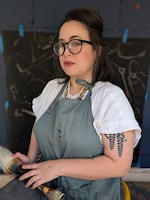In her home in Hillsboro, Oregon, Lindsey Holcomb squeezes drops of teal alcohol ink onto paper and watches the colors bloom. She’s translating MRIs into artwork to help people cope with their diagnoses of multiple sclerosis and other brain injuries.

Transforming MRIs into artwork, Lindsey Holcomb is helping people cope with multiple sclerosis.
Jason Holcomb
Holcomb remembers what it felt like when she was first diagnosed with MS in 2017.
“It was a fearful moment,” she said, 35 years old at the time and the mother of two young girls.
She left the neurology office and created an abstract painting of her MRI.
“It was a diary entry,” she said.
She dripped alcohol ink onto paper and rolled the ink around by squeezing air from a bulb syringe and tipping the paper back and forth. The paint drips looked like brain folds.
“When I finished it, I felt a lot better and I felt like I could maybe digest things a little bit more the next day.”
She posted it on her social media, and the National MS Society shared it on their channel.
“It catapulted me into art,” she said.
Holcomb has since painted 400 brain scans for people across the United States and 14 countries.
Finding beauty in the broken
Artist Lindsey Holcomb has painted MRIs for 400 people around the world.
Lindsey Holcomb
Before starting an MRI painting, Holcomb gets information from her clients about their journeys with MS and their artistic preferences.
Holcomb’s work is meticulous. She studies the folds and the lesions in the MRI.
She says her favorite part is cutting out the lesions with a wood-burning pen and tracing the holes with gold. “It feels like applying a balm,” she said.
It echoes kintsugi, the Japanese art of repairing broken pottery with gold lacquer.
“It’s not about hiding the cracks—it’s about honoring them.”
Holcomb sews thread into her artwork to add contrasting texture against the glossy ink. The thread once belonged to her late grandmother, a seamstress. “It’s my way of honoring her.”
Working with symptoms of MS
Before beginning to paint, Holcomb scoops her arms into horizontal circles like a dancer stretching before a performance. She calls it “artist yoga” — a moment to check in with her body to see what it can do that day.
Holcomb deals with fatigue, spasticity, double vision, and fine-motor challenges. On some days, her vision blurs like torn tissue paper; on others, her hands tremble. She’s learned to adapt.
“I’ve challenged myself in the last two or three years to create with my eyes closed,” she said. “It’s scary, but also kind of a puzzle.”
Not only are the intricate MRI paintings becoming harder to execute, the emotional toll is starting to weigh on Holcomb.
“There’s a heaviness to making space for somebody’s story and their imagery,” she said. “When the image is different from my own, I think there’s always something in your mind thinking, ‘Could I be experiencing that soon?’”
“If I do too many MRIs too often, it feels like I’m being diagnosed over and over again.”
She now limits how many MRI commissions she accepts.

Living with MS, Hillsboro artist Lindsey Holcomb says she feels triumphant when she paints bold, sweeping arcs in her Torii series.
Lindsey Holcomb
Instead, she leans into a newer series, titled Torii. The abstract works with bold arcs and circles are pieces she can see clearly even on her worst vision days.
“It felt triumphant to be able to do these really smooth, large shapes.”
Holcomb says she feels freer with the series. It’s less detailed work, which is easier on her body.
It has also become a joyful collaboration with her children, who point out shapes they see in the artwork.
In one painting, the girls identified a floating baby head. “It’s something you cannot unsee!” says Holcomb.
A silver lining
“There is a silver lining to living with MS,” says Holcomb.
Before her MS diagnosis, Holcomb worked in event planning and administration — roles that required managing everyone else’s stress.
“My joy is much better and bigger, pursuing a more creative path,” she says.
“I hope my children see that there’s nothing worth working yourself to depletion for. I hope they chase their spark. I hope they chase that new crayon box smell.”
